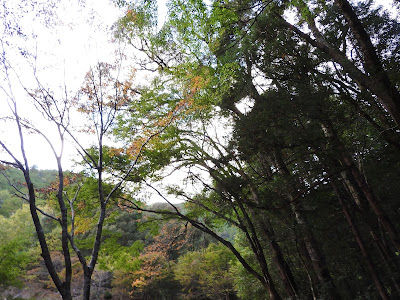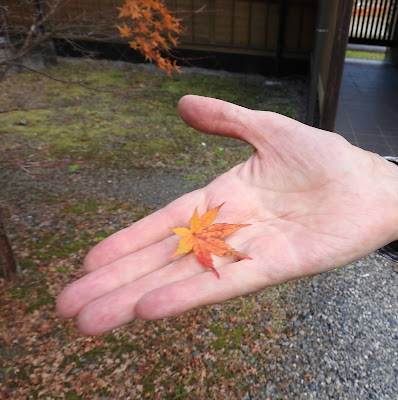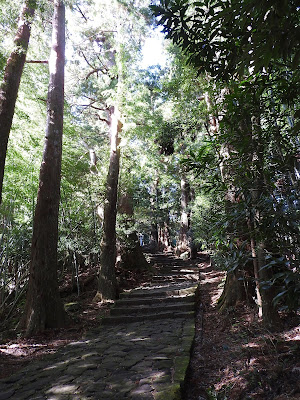 |
| 熊野・南紀旅行 11月12 - 14日 Kumano and Nanki Trip 12 -14th of November Kii Peninsula Trip |
 |
| 添乗員さん作成の予定表 実際の順番はいくつか変更になりましたが、 最後の '発心門王子 (ホッシンモンオウジ) 跡' は 最後のままでした。 Schedule Created by Our Tour Conductor The actual order was changed, though 'Hosshinmon Prince', was the last. |
目次 / Contents
1) 熊野古道 / Kumano Kodō
2) '王子' は神社 / 'Prince' is Shrine
3) '熊野九十九王子' / 'Kumano, Ninety-nine Princes'
4) 遠い昔に / A Long Time Ago
A. 門 / Gate
B. 猪鼻王子から / From Inohana Prince
5) 秋 / Autumn
6) 熊野三山の感想 / Impression of Kumano Sanzan
Kumano Kodō
Kumano Kodō is a general term for pilgrimage routes leading to "Kumano Sanzan" : 'Three Grand Shrines of Kumano',
and there are mainly six routes, below.
2) '王子' は神社 / 'Prince' is Shrine
 |
| 発心門王子 住所 和歌山県田辺市本宮町三越字上久保1652 この社殿は、1990年に再建されました。 発心門王子跡を訪ねた時、私は、発心門王子について よく理解していませんでした。 '王子' が神社を意味することさえも知りませんでした。 Hosshinmon Prince Address : 1652 Kamikubo, Mikoshi-aza, Hongū Town, Tanabe City, Wakayama Prefecture This shrine was rebuilt in 1990. When I visited the site of Hosshinmon Prince, I didn't understand Hosshinmon Prince very well. I didn't even know that 'Prince' means a shrine. 動画は下記より / This from below★ |
3) '熊野九十九王子'
'Kumano, Ninety-nine Princes'
 |
| 熊野古道マップ A : 大門坂 B : 発心門王子 C : 高野坂 D : 清水峠 E : 長井坂 参詣者の守護を祈願する神社、 が建てられました。 99あるわけではなく、九十九は多数あるという比喩ですが、 実際、最盛期の12 - 13世紀には、99前後の王子がありました。 A: Daimonzaka B : Hosshinmon Prince C: Kouyazaka-hill D: Shimizu Ridge E: Nagaisaka-hill 'Kumano, Ninety-nine Princes' built along the roadside of by Shugenja (Yamabushi) and were there for the protection of praying worshipers, from the 12th to 13th centuries. 'Ninety-nine' was a metaphor, there were not exactly 99, but many, although in fact, in the 12th to 13th centuries, there were around 99 princes. (I will write 'Ninety-nine Princes' shrines ; '99 Princes'.) |
時代とともに、熊野詣が下火になり、また、明治 (1868 - 1912) 以降の神道の国家神道化とそれに伴う合祀、市街化による廃絶などにより、九十九王子の旧社地が失われたり、場所が不明になったものも多くあります。
そこには、'九十九王子' の最後の一社、多富気王子(タフケオウジ / タフケオウジ) 跡がありましたが、私は'九十九王子' のことも知りませんでしたし、多富気王子は木々の中にある石碑で、鳥居もなかったので、見過ごしました。
九十九王子には五体王子(ゴタイオウジ)と呼ばれる王子があり、他とは格式を異にし、現在でも神社としての外見または建物を維持しています。
その中でも、発心門王子は最も有名です。
大門坂のセクションで、多富気王子・五体王子について書いています(下記)。
他の '熊野詣で'に関係した観光地同様、ここも、世界遺産『紀伊山地の霊場と参詣道』に指定されています。
山の中のひっそりとした場所で、こじんまりした、神社と祠の間の建物があり、世界遺産指定記念碑がばかに立派で、チグハグな印象を受けました。
(世界遺産指定記念碑はかっこいいですよ)
'Kumano, Ninety-nine Princes'
With the passage of time, the Kumano pilgrimage declined, and many of the old shrines were lost or the location became unknown due to State Shinto of Shinto after the Meiji era (1868 - 1912) and the accompanying enshrining and abolition due to urbanization.
On this day, we went to Daimonzaka-hill on Kumano Kodō, which leads to Kumano Nachi Taisha Shrine.
There was a monument of Tafuke Prince : the last one of '99 Princes', but I didn't know about '99 Princes, and the Prince is a stone monument in the woods, without Torii, so I missed seeing it.
There are 'Five Princes' called 'Gotai-oji' among the '99 Princes', which are higher class in form, compared to the others, and still maintain their appearance or building as shrines.
Among them, Hosshinmon Prince is the most famous.
In the section of Daimonzaka-hill, I wrote about Tafuke Prince and 'Five Princes', below.
Like other tourist destinations related to 'Kumano Pilgrimage', this place was also designated as a World Cultural Heritage Site of the Sacred Sites and Pilgrimage Routes in the Kii Mountain Range.
In a quiet place in the mountains, there is a small building between the shrine and the Hokora, and the World Heritage monument is ridiculously magnificent and gives a dissonant impression.
(The World Heritage Site Monument is cool)
According to Wiki about Hokora,
"Hokora is a miniature Shinto shrine either found on the precincts of a larger shrine and dedicated to folk kami, or on a street side, enshrining kami not under the jurisdiction of any large shrine."
4) 遠い昔に / A Long Time Ago
A. 門 / Gate
'発心門' は山岳信仰の四門修行 (シモンシュギョウ) に由来しています。
山上の聖地に至る間に発心・修行・等覚・妙覚の4つの門 : ★を設け、それらを通り抜けることによって悟りが開かれると考えられ、その実践が四門修行です。
発心とは、発菩提心 (ホツボダイシン)、菩提心を起こすこと、悟りを得ようと仏道(仏門) に入り、修行への志を固めることです。
現在では、物事を始めようと思い立つ時に、発心という言葉を用いますね。
発心門とは聖域への入り口を意味しています。
1109年、藤原宗忠 (フジワラ ノ ムネタダ / 1062 - 1141) の日記、
『中右記』(チュウユウキ / 1087 - 1138) に、
"ここに大鳥居があり、参詣の人々はその前で祓いをして鳥居をくぐった"
とあり、そのそばにこの神社があったので、発心門王子の名前がついたと言われています。
遠い昔、人々が厳かな気持ちで、鳥居を通り抜けて、聖域へ入った風景が目に浮かびます。
現在は大鳥居はありませんが、発心門王子の場所はそんなに広くはないのに、鳥居が2つあるのは、大鳥居のかわりなのではないかと思います。
1つは発心門王子へ、もう1つは聖域への鳥居と私は考えます。
2つ目の鳥居は、猪鼻王子 (イノハナオウジ) へ向かう道の入り口に建てられています。
 |
| 国の史跡・"熊野参詣道" (2000年) の一部。 南無房堂址(ナムボウドウアト)とともに 県指定史跡(1967年)。 南無房堂址は、発心門王子の後方あった宿所(尼庵)です。 1201年に 藤原定家 (フジワラノテイカ / 1162 -1241) が 泊まったと言われています。 Part of the National Historic site "Kumano Kodō" (2000). A historic site designated by the prefecture (1967), along with the ruins of Namubou-do. It is said that Fujiwara no Teika (1162 -1241) stayed in Namubou-do, which was a lodgings, behind the Hosshinmon Prince in 1201. 動画は下記より / This from below ★ |
"Fujiwara Sadaie (藤原定家), better-known as Fujiwara no Teika was a Japanese poet, critic, calligrapher, novelist, anthologist, scribe, and scholar of the late Heian and early Kamakura periods"
The word 'Hosshinmon' came from the 'Four Training Gates' of mountain worship.
It is thought there are Four Gates :
1) 発心 - Hosshin ; Decide enter Buddhism
2) 修行 - Shugyō ; Practice for mental and body
3) 等覚 - Toukaku ; Close to Buddha
4) 妙覚 - Myokaku ; reaching Buddha Area
and people go through these and then enlightenment will be opened.
'Four Training Gates' is doing these.
Hosshin means making Bodhicitta, to enter Buddhism for spiritual awakening and deciding on the ambition for training.
In Japan, nowadays, when you think about starting things, you use this word, "Hosshin" : 発心.
'Hosshinmon' means the entrance to the sanctuary.
'Kumano Pilgrimage' was spread (popularized) by "Kumano-gokō" (Royal family visited Kumano Sanzan as pilgrims).
The first visit to Kumano Sanzan was at Kumano Hongū Taisha Shrine.
Unlike now, people had come all the way to Kumano region, which has been said to be the "Land of Resurrection," even when travel was not well developed.
In 1109, "Chuyuki " (1087 - 1138) , the diary of Fujiwara-no-Munetada (1062 - 1141) says,
"There is a Great Gate : Otorii here, and pilgrims purified themselves in front of the Gate and they went through the Gate."
It is said that the name of Hosshinmon Prince was given because the Prince was near the Gate.
I can imagine the scenery, that people went through the Great Gate with a solemn feeling and entered the sanctuary.
Currently, there is no the Great Gate, and Hosshinmon Prince area is not so large, but I think that there are two Torii gates instead of the Great Gate.
In my view, one is to the Hosshinmon Prince and the other is for the sanctuary.
The second gate is built at the entrance of the path to Inohana Prince.
B. 猪鼻王子から / From Inohana Prince
 |
| ←左:熊野本宮大社 右 : 猪鼻王子800m→ ←Left : Kumano Hongū Taisha Shrine Right : Inohana Prince, 800m→  猪鼻王子へ ここを800m進むと猪鼻王子があるようです。 この道が、本当の熊野古道、中辺路なんですね。 この道の入り口(出口?)に鳥居 (下の画像) があります。 To Inohana Prince If you go for 800m from here, you will find Inohana Prince. This path is the true Kumano Kodo, Nakahechi. There is a torii gate, below at the entrance (exit?) of this path. 発心門 現在、この鳥居が発心門と呼ばれているようです。 赤い祠が発心門王子。 昔、人々は京を出て中辺路を通り、猪鼻王子を経て登ると ここに出てくるのですね。 Hosshinmon-gate Currently, this torii seems to be called Hosshinmon-gate. The red Hokora (shrine) is Hosshinmon Prince. Once upon a time, people came from Kyoto, passed through Nakahechi, Inohana Prince, climbed and reached here. 画像は下記より / This from below |
 |
| 熊野古道の1つ; '中辺路' 右に熊野本宮大社があります。 One of Kumano Kodō : 'Nakahechi ' From the left (west) to the right (east) of the map, people arrive at Kumano Hongu Taisha on the far right.  下記、Wikiより "三越峠 (ミコシトウゲ) から音無川 (オトナシガワ) 源流の谷川沿いを進み、 猪鼻王子を過ぎると、参詣道は坂道となり、谷を離れる。 小渓流を横目にシダの茂る坂道を登りきり、鳥居(発心門)をくぐったところで、 発心門王子の社地が目に入ってくる。" 画像は下記より / This from below ★ |
 |
| 王子は木々の中、鳥居は右です。 この木々は時期が進むと赤く染まるのでしょうか? The Prince is in the trees and the torii gate is on the right. Will these trees turn red as the season progresses? |
5) 秋 / Autumn
1201年、晩秋から初冬にかけて
後鳥羽院 (1180 - 1239 / 在位: 1183 - 1198)
の参詣一行に藤原定家は随行していました。
前述しましたが、この時、定家は、発心門王子裏の南無房堂に泊まり、"建仁参詣記"のなかで、
"この王子の社は思わず信心をかきたてられるほどに神々しく、さらに社殿の周囲にすきまなく生い繁った木々がみな紅葉し、風が紅葉を舞い散らして境内に散る、荘厳で美しいさま"
を伝えています : ★。
["建仁参詣記" : 定家の書き残した日記『熊野道之間愚記(後鳥羽院熊野御幸記)』]
運よく、私達が発心門王子を訪ねた時も、秋....
木々はほんの少し、色づいていました。
Autumn
In 1201, from late autumn to early winter, Fujiwara no Teika accompanied a group of "Kumano-gokō" of
Emperor Go-Toba (1180 - 1239 / reign : 1183 - 1198).
As mentioned above, at this time, Teika stayed in Namubou-do behind the Hosshinmon Prince.
"Kennin Sankei-ki" [Diary about "Kumano-gokō" by Teika]
"This prince's building is so divine that it can arouse devotion, and it is very beautiful that all the trees that grow without gaps around the shrine turn red, and the wind scatters the autumn leaves and swirls them in the precincts."
Fortunately, when we visited Hosshinmon Prince, it was autumn ....
The trees were just a little colored.
 |
| 空はまだ明るいですが、木々の中は薄暗い。 The sky is still bright, but under the trees is subdued. |
 |
| 大きなモミジ、まだ葉が緑です。 色づいたら、さぞや華やかでしょう。 緑は緑で綺麗です。 Large Maple, leaves are still green. When it is colored, it will be gorgeous. Green is beautiful as green. |
 |
| 駐車場なので、周囲が開けているので 明るいです。 Since it is a car park, it is bright because the surroundings are open.  |
 |
| バスから熊野の山の紅葉を見る See the autumn leaves of the mountains of Kumano from our coach. |
 |
| 地ビール ホテルで、地ビールのナギサビールを味わう 美味しく飲みました! Craft Beer Taste craft beer, Nagisa Beer in the hotel. We enjoyed! |
6) 熊野三山の感想
Impression of Kumano Sanzan
ツアーなので、それぞれの場所で時間がないことは多々あり、残念な思いもあります。
Impression of Kumano Sanzan
ツアーなので、それぞれの場所で時間がないことは多々あり、残念な思いもあります。
けれども、体には優しいスケジュールでした。
ツアーは、古来からの巡礼者の思いとは程遠く、本来の熊野古道の経験は全くないに等しい内容でした。
ですが、たとえそうであったとしても、ずっと行きたかった熊野古道を少しでも経験できたことは私の精神的な健康さにつながります。
古来の巡礼者の幻影を多少は感じられたように思います。
八咫烏にもとても興味があります。
それはファンタジー好きのマイナーさであると思っていましたが、
自分の無知さもまた、思い知りました。
和歌山を訪れる機会があるなら、ポイントを絞って、その場所をゆっくり見たいと思います。
次のセクションは、アドベンチャーワールドで、Rがずっと楽しみにしていたコンテンツです。
Impression of Kumano Sanzan
Since it's a tour, I often don't have enough time at each place, which is a shame.
However, it was a gentle schedule for my body.
Our tour was far from the thoughts of pilgrims from ancient times, and the content was almost completely unrelated to the original Kumano Kodō.
However, even so, being able to experience the Kumano Kodō, where I've always wanted to go, leads to my mental well-being.
I think I felt some of the illusions of ancient pilgrims.
I am also very interested in Yatagarasu, which is a three-legged crow, messenger of the Kumano Gods.
I thought Yatagarasu, was only of interest to a fantasy-loving minority, but it is used as a symbol of the Japan Football Association, and it is still treated as a God's messenger in Kumano Sanzan and I was surprised by it being so well-known.
I also realized my ignorance.
If I have a chance to visit Wakayama again, I would like to narrow down the focus and take a leisurely look at a few places.
The next section is Adventure World, the content that R has been looking forward to.











0 件のコメント:
コメントを投稿